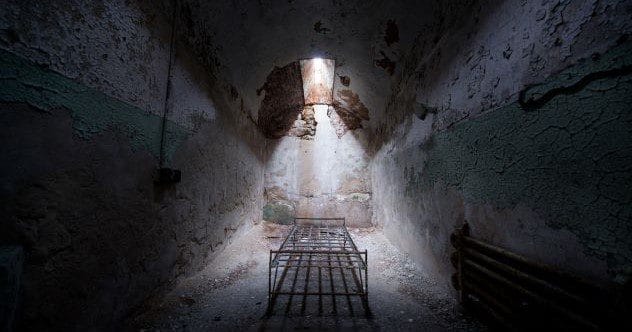Eastern State Penitentiary (ESP) in Philadelphia stands as America’s first large-scale penitentiary. While jails existed before, ESP was the first mega-prison, setting the blueprint for modern incarceration. Let’s delve into ten fascinating and jaw-dropping facts about this historic prison.
10. A Big Idea at Walnut Street Jail
In 1821, Philadelphia and Pennsylvania invested $100,000 to expand the Walnut Street Jail, envisioning a revolution in incarceration. Thomas Bradford, an inspector, advocated for solitary confinement, religious instruction, and trade skills education. This “Pennsylvania system” aimed to inspire penitence, provide faith-based guidance, and equip inmates with survival skills. Prison officials hoped that solitary confinement would allow prisoners to reflect on their misdeeds and correct them. [1]
9. Soon, No Expense Is Spared
By 1829, ESP featured a radial design with seven cell blocks, each containing 76 cells separated by 18-inch thick stone walls. Inmates lived in these cells virtually all day, with toilets and sinks provided. Completed in 1836, ESP cost $780,000 (nearly $25 million today), making it one of the most expensive buildings in the U.S. The first prisoner, Charles Williams, was admitted in late 1829, sentenced to two years for stealing a gold key and a silver watch worth about $800 today. [2]
8. Life in Solitary
Most cells measured 12 x 8 feet, confining inmates for 23 hours a day. They had one hour for exercise, provided they behaved. The prison aimed to “induce and effect reform” through solitary confinement. Inmates worked with their hands, making chairs, textiles, or shoes sold to fund prison upkeep. Guards restricted access to reading and writing materials, and family visits were forbidden to intensify isolation. Religious services maintained isolation by separating inmates with hoods and partitions. [3]
7. Terrorized Inmates & Tortured Souls
Solitary confinement was a form of torture, but officials used even more draconian methods. Inmates faced waterboarding, iron gags that choked them with slight movement, and hot steam in cramped quarters. These punishments often led to deaths. In 1834, Warden Samuel R. Wood was accused of torture and embezzlement but was acquitted. By the early 20th century, difficult prisoners were placed in 4 x 8 feet cells, leading to insanity due to rage and loneliness. [4]
6. ESP’s Infamous Inmates
ESP housed famous felons like William Francis Sutton, also known as “Slick Willie,” a bank robber sentenced to 25 to 50 years in 1934. He escaped after 11 years but was quickly caught and re-sentenced to life. Al Capone, the notorious Chicago gangster, was also imprisoned at ESP for bootlegging. Leo Callahan escaped in 1923 and was never caught, marking a rare successful escape from ESP. [5]
5. Overflow Brings Despair
By the late 19th century, ESP’s population quadrupled to over 1,000 inmates, leading to high death rates. In the first 20 years, roughly 10% of inmates died, with a quarter of the Black population dying in the early decades. Overcrowding worsened in the early 1900s, with two men per cell, causing diseases like tuberculosis to spread. Underground cells called “Klondike,” without windows or plumbing, were built to accommodate the overflow. By 1913, any remnants of solitary confinement were scrapped. [6]
4. Fed-Up Inmates Revolt
As conditions worsened, inmates revolted. In the 1840s, 11 Black inmates coordinated a mass escape through plumbing pipes, with three former slaves escaping to freedom. In 1933, inmates revolted against alleged torture, but guards suppressed the uprising. The largest revolt occurred on January 8, 1961, with over 800 prisoners fighting guards. The revolt and its aftermath were so bloody that records were destroyed. [7]
3. Even Dogs Faced the Music
In 1924, a black lab named Pep was “sentenced” to life for supposedly killing the governor’s wife’s cat. Given the number C-2559, Pep’s story went viral, though public reaction was critical, feeling the governor was mistreating an innocent animal. In 1926, the governor explained that Pep was living well and the sentence was a joke. Pep lived at ESP until 1928, then moved to another prison, remaining popular among inmates. [8]
2. From Torture to… Tourism?
Even when ESP was operational, it was a popular tourist attraction. Visitors were drawn by tales of terrible conditions and infamous inmates. By the mid-19th century, it was a top tourist destination in Philadelphia. Charles Dickens visited in 1842 and was horrified by the solitary confinement conditions. He described the prisoners as “buried alive” and dead to everything but “torturing anxieties and horrible despair.” [9]
1. The End of Eastern State
By the 1950s, Pennsylvania started to reform ESP, renaming it “State Correctional Institution-Philadelphia” and adding a diagnostic center for mentally ill inmates. However, conditions continued to deteriorate, leading to the prison’s closure in 1971. The city debated its use, and the facility fell into disrepair for two decades. In 1991, Philadelphia designated it a historical landmark and began offering tours, initially during Halloween. Today, tours are year-round, and a museum opened in 1994, displaying artifacts and stories about ESP’s past. [10]
Eastern State Penitentiary’s history is a stark reminder of the evolution of incarceration and the impact of severe conditions on inmates. From its ambitious beginnings to its current state as a historical site, ESP offers a unique glimpse into America’s penal past.
What do you think about these facts? Leave your comments below!










